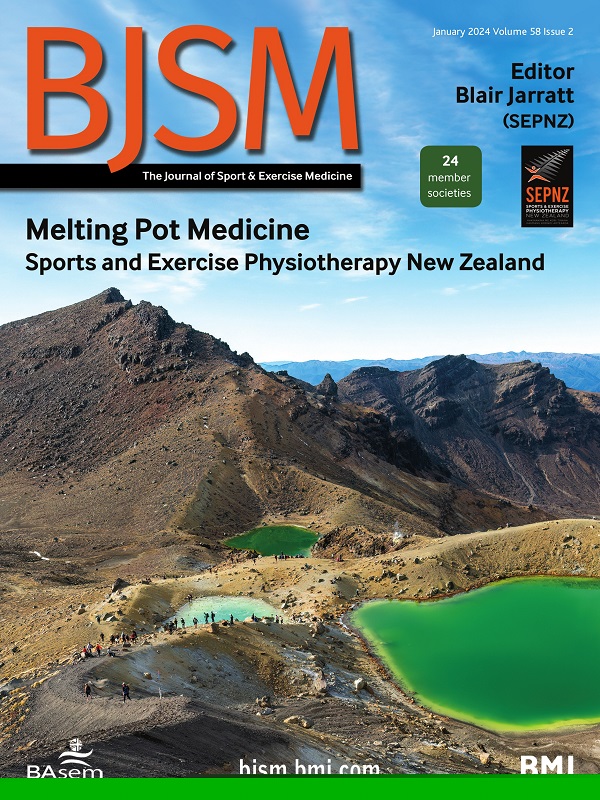Is hip adductor or abductor strength in healthy athletes associated with future groin pain? A systematic review and meta-analysis
IF 16.2
1区 医学
Q1 SPORT SCIENCES
引用次数: 0
Abstract
Objective To systematically review the association between hip adduction and abduction strength, and adduction-to-abduction strength ratio in healthy athletes with the occurrence of future groin pain and time-loss groin injuries. Design Systematic review with meta-analysis. Data sources PubMed, Web of Science, SPORTDiscus, PEDro, Embase, and Scopus. Eligibility criteria Studies included had to (1) measure hip adductor or abductor strength in healthy athletes, (2) conduct a follow-up period to assess the occurrence of groin pain, (3) present strength data separately for participants who remained uninjured and those who suffered an injury and (4) use a prospective design. Risk of bias was assessed according to the Quality in Prognosis Studies tool. The certainty in the evidence appraised was measured using the Grading of Recommendations Assessment Development and Evaluation approach. Results Thirteen prospective cohort studies met the inclusion criteria. Overall study risk of bias was rated as low. Players who remained uninjured had stronger adduction strength compared with players who subsequently suffered groin pain (standardised mean differences with 95% CIs (SMD=−0.5, 95% CI −0.92 to −0.09)) and time-loss groin pain (SMD=−0.68, 95% CI −1.31 to −0.06). Trivial effects were observed for abduction strength (groin pain SMD=0.03, 95% CI −0.11 to 0.17; time-loss SMD=−0.07, 95% CI −0.25 to 0.11) and adduction-to-abduction strength ratio (groin pain SMD=−0.02, 95% CI −0.55 to 0.51; time-loss SMD=−0.11, 95% CI −1.11 to 0.89). Age and diagnostic criteria were not significant moderators of the relationship between adductor strength and groin pain (p=0.72 and p=0.12). Conclusion There is a moderate effect of hip adductor strength on the occurrence of groin pain, while there is no relationship between either abductor strength or the ratio of adductor-to-abductor strength with the occurrence of groin pain. PROSPERO registration number CRD42024548630. Data are available upon reasonable request.健康运动员的髋关节内收或外展力量与未来腹股沟疼痛有关吗?系统回顾和荟萃分析
目的 系统回顾健康运动员的髋关节内收和外展力量以及内收与外展力量比值与未来腹股沟疼痛的发生和腹股沟损伤时间损失之间的关系。设计 采用荟萃分析法进行系统回顾。数据来源:PubMed、Web of Science、SPORTDiscus、PEDro、Embase 和 Scopus。资格标准 所纳入的研究必须:(1)测量健康运动员的髋关节内收或外展力量;(2)进行随访以评估腹股沟疼痛的发生情况;(3)分别提供未受伤和受伤运动员的力量数据;(4)采用前瞻性设计。偏倚风险根据预后研究质量工具进行评估。所评估证据的确定性采用建议分级评估开发和评价方法进行衡量。结果 13 项前瞻性队列研究符合纳入标准。研究的总体偏倚风险被评为低。与后来腹股沟疼痛的球员相比,未受伤的球员具有更强的外展力量(标准化平均差与 95% CIs (SMD=-0.5, 95% CI -0.92 to -0.09)),而腹股沟疼痛的时间损失(SMD=-0.68, 95% CI -1.31 to -0.06)。外展力量(腹股沟痛SMD=0.03,95% CI -0.11至0.17;时间损失SMD=-0.07,95% CI -0.25至0.11)和内收与外展力量比(腹股沟痛SMD=-0.02,95% CI -0.55至0.51;时间损失SMD=-0.11,95% CI -1.11至0.89)的影响微乎其微。年龄和诊断标准对内收肌力量和腹股沟疼痛之间的关系没有显著调节作用(P=0.72 和 P=0.12)。结论 髋关节内收肌力量对腹股沟疼痛的发生有一定的影响,而外收肌力量或内收肌力量与外收肌力量的比率与腹股沟疼痛的发生没有关系。PROSPERO 注册号为 CRD42024548630。如有合理要求,可提供相关数据。
本文章由计算机程序翻译,如有差异,请以英文原文为准。
求助全文
约1分钟内获得全文
求助全文
来源期刊
CiteScore
27.10
自引率
4.90%
发文量
217
审稿时长
3-8 weeks
期刊介绍:
The British Journal of Sports Medicine (BJSM) is a dynamic platform that presents groundbreaking research, thought-provoking reviews, and meaningful discussions on sport and exercise medicine. Our focus encompasses various clinically-relevant aspects such as physiotherapy, physical therapy, and rehabilitation. With an aim to foster innovation, education, and knowledge translation, we strive to bridge the gap between research and practical implementation in the field. Our multi-media approach, including web, print, video, and audio resources, along with our active presence on social media, connects a global community of healthcare professionals dedicated to treating active individuals.

 求助内容:
求助内容: 应助结果提醒方式:
应助结果提醒方式:


